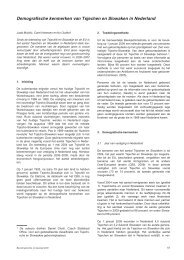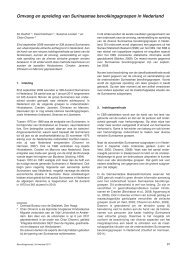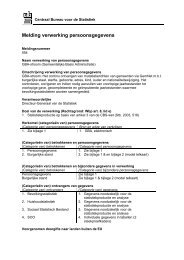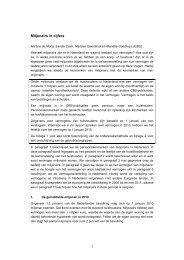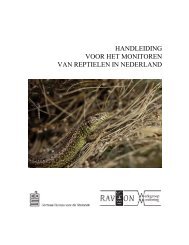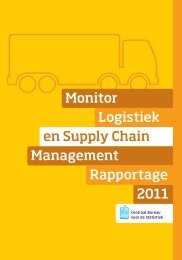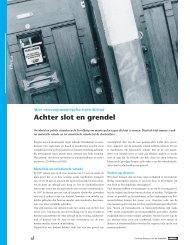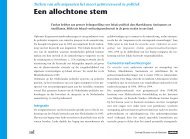Methoden voor de berekening van de emissies door mobiele ... - CBS
Methoden voor de berekening van de emissies door mobiele ... - CBS
Methoden voor de berekening van de emissies door mobiele ... - CBS
Create successful ePaper yourself
Turn your PDF publications into a flip-book with our unique Google optimized e-Paper software.
Figure 1.1 Calculating emissions from road traffic, actual emissions of CO, VOC, NOx, N2O,<br />
NH3, and PM10 due to combustion of motor fuels<br />
BASIS EMISSION FACTORS<br />
gram/vehicle km<br />
per - vehicle class<br />
- year of manufacture<br />
- road type<br />
YEAR OF MFG EMISSION<br />
FACTORS gram/vehicle km<br />
per<br />
per<br />
- year of manufacture<br />
- vehicle category<br />
- fuel type<br />
- road type<br />
EMISSIONS mln kg<br />
- year of manufacture<br />
- vehicle category<br />
- fuel type<br />
- road type<br />
WEIGHTING FACTORS<br />
(according to vehicle kms)<br />
per<br />
- vehicle class<br />
- year of<br />
manufacture<br />
TRAFFIC<br />
PERFORMANCE<br />
per<br />
- year of manufacture<br />
- vehicle category<br />
- fuel type<br />
- road type<br />
The year of manufacturing emission factors are then multiplied by the vehicle kilometres travelled (per<br />
year of manufacturing and per vehicle category – the lowest diamond in Figure 1.1) to arrive at the<br />
emissions per vehicle category per road type. Until 1997 the allocation of vehicle kilometres travelled<br />
to road type is based on the figures from Statistics Netherlands about the use of roads (see 1.5.1).<br />
Recent allocation figures are based on a survey by the Goudappel Coffeng Agency commissioned by<br />
the Emission Registration<br />
Section 1.5.1 addresses the required vehicle kilometres travelled data. The methodology for<br />
ascertaining the basic emission factors and aggregating this data according to year of manufacturing<br />
factors is <strong>de</strong>scribed in Section 1.6.1.<br />
The emissions of individual volatile organic substances are calculated by using a substance profile.<br />
This is <strong>de</strong>scribed in Section 1.4.1.<br />
Combustion of motor fuels; SO2, CO2 and heavy metals<br />
Figure 1.2 shows the calculation method used for the emissions of SO2, CO2 and heavy metals by<br />
road traffic resulting from combustion. Compared with the method <strong>de</strong>scribed above for calculating<br />
carbon monoxi<strong>de</strong> combustion emissions, for example, the calculation method for SO2, CO2 and heavy<br />
metal emissions caused by road traffic is much simpler. The reason is that the emissions of these<br />
substances can be directly related to the fuel consumption of vehicles and to the type of fuel.<br />
Regarding the method of ascertaining the fuel consumption per vehicle, fuel type and road type (right<br />
diamond in Figure 1.2), see Section 1.5.1. The final emission calculation involves multiplying emission<br />
factors (gram/litre of fuel) with the fuel consumption per vehicle category, fuel type and road type.<br />
17





